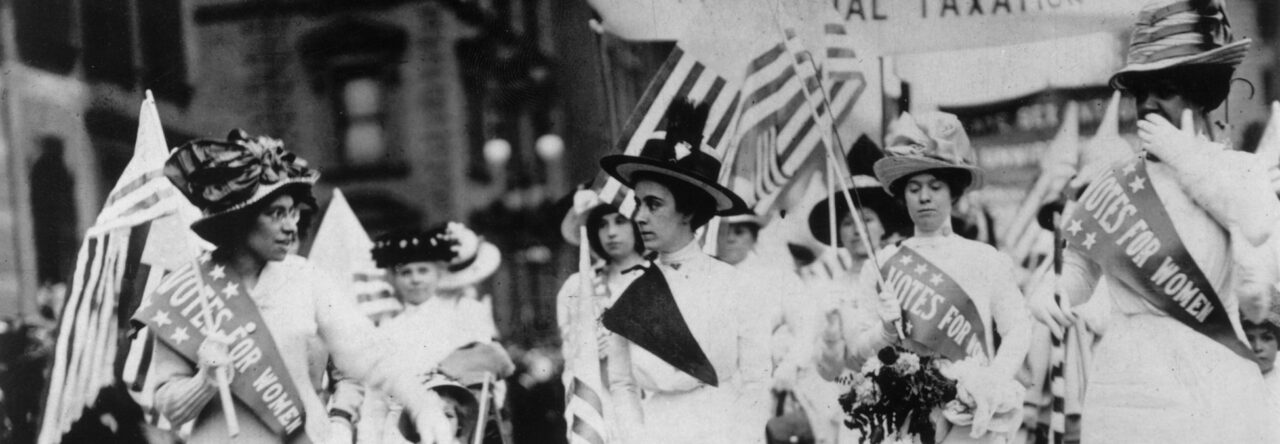 http://www.loc.gov/pictures/resource/cph.3b23344/, this photo is a public domain image from the Library of Congress.
http://www.loc.gov/pictures/resource/cph.3b23344/, this photo is a public domain image from the Library of Congress.
“Wherever one went, it was impossible not to notice the predominance of women voters during the forenoon,” the Boston Daily Globe reported on November 3, 1920. The previous day, the first Presidential election was held since the Nineteenth Amendment to the United States Constitution granted women over the age of 21 the right to vote earlier that year (“Women by Thousands Pour Into Polling Places in the Bay State.” Boston Daily Globe. 3 November, 1920, 20.).
The 1920 Presidential Election, the first since the conclusion of World War One, pitted Ohio Republican Senator Warren G. Harding and his running mate, Massachusetts Governor Calvin Coolidge against Ohio Democratic Governor James M. Cox and former Assistant Secretary of the Navy and future President Franklin D. Roosevelt. Harding and Cox vied to succeed two term Democratic President Woodrow Wilson (“The Presidential Election of 1920.” United States Library of Congress. http://memory.loc.gov/ammem/nfhtml/nfexpe.html). According to historians William Binning, Larry Esterly, and Paul Sracic, the election was “a referendum on the Wilson administration,” especially in terms of the outgoing President’s ardent support for the nation’s entry into the new League of Nations, the unpopularity of which led many voters to favor Harding’s calls for a return to normalcy (Binning, William, and Larry Esterly and Paul Sracic. Encyclopedia of American Parties, Campaigns and Elections. Westport, CT: Greenwood Press, 1999, 66). Unlike his Democratic opponent, Harding took a firm stand on the other major issue of the campaign when he “pledged to enforce” the Eighteenth Amendment to the United States Constitution, which the previous year prohibited alcohol, according to historian David Kyvig (Kyvig, David. Repealing National Prohibition. Chicago: University of Chicago Press, 1979, 29).
On Election Day, November 2, 1920, many women rushed to exercise their newfound right to vote. The Boston Daily Globe reported the following day that when the polls opened in the morning in many towns outside the city “women, old and young, married and single, most of them under no compulsion to vote at that daylight hour, had come forward with pride and eagerness to be among the first.” The Boston Daily Globe also reported that a number of women voters initially failed to grasp the concept of the anonymous secret ballot, as evidenced by a woman asking the warden at a polling place “Do I sign my name on the back of the ballot?” (“Women by Thousands Pour Into Polling Places in the Bay State.” Boston Daily Globe. 3 November, 1920, 20.). The New York Times reported that “Women showed intense interest in the election. In many districts, more women than men went to the polling places in the morning. In the first hour, it was not uncommon to see when on their way either from or to the grocery” (“Thousands Carry Lunches to the Polls.” New York Times. 3 November, 1920, 11).
This influx of motivated women voters, which was seen throughout the nation, likely contributed to Harding’s landslide victory, the largest since “the Republican landslide of 1904,” in which Theodore Roosevelt won his second term. (“Cox and League Buried Under Huge Majority.” Chicago Daily Tribune. 3 November, 1920, 1).
This conclusion is supported by statisticians Malcolm Wiley and Stuart Rice, who studied voting records in the state of Illinois, where male and female ballots “were separately recorded,” in addition to simultaneous local elections where social issues played prominent roles. Rice and Wiley determined that women voters, “especially in the northern states” trended more Republican than their male counterparts because women tended to be on the “’moral’ and conservative sides in local elections,” and “Harding of the two candidates was widely believed to be the more conservative,” on social issues such as prohibition. (“Rice, Stuart, and Willey, Malcolm. “A Sex Cleavage in the Presidential Election of 1920.” Journal of the American Statistical Association 19, no. 148, (1924): 519-520.)

